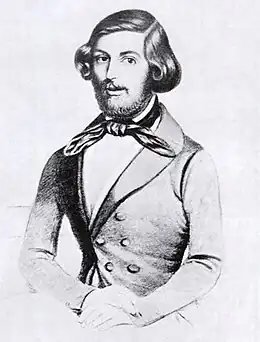Gotthold Eisenstein
Ferdinand Gotthold Max Eisenstein ( - ) est un mathématicien prussien.

| Naissance | |
|---|---|
| Décès |
(à 29 ans) Berlin |
| Nom dans la langue maternelle |
Ferdinand Gotthold Max Eisenstein |
| Nationalité | |
| Formation | |
| Activité |
| A travaillé pour | |
|---|---|
| Membre de | |
| Directeurs de thèse |
Ernst Kummer, Johann Peter Gustav Lejeune Dirichlet, Nicolaus Wolfgang Fischer (d) |
| Distinction |
Biographie
Comme Galois et Abel, Eisenstein est mort avant l'âge de 30 ans, et comme Abel, sa mort est due à la tuberculose. Il est né et mort à Berlin, Allemagne. Il fit ses études à l'Université de Berlin où Dirichlet était son professeur.
Gauss aurait déclaré[1] : « Il n'y a que trois mathématiciens qui feront date : Archimède, Newton et Eisenstein. » Le choix par Gauss d'Eisenstein, lequel s'était spécialisé dans la théorie des nombres et l'analyse, peut sembler étrange à certains, mais il est justifié par le fait qu'Eisenstein avait prouvé facilement plusieurs résultats jusqu'alors inaccessibles, même à Gauss, comme d'étendre son théorème de réciprocité biquadratique (en) au cas général.
Bibliographie
- Allan Adler: Eisenstein and the Jacobean Variety of Fermat curves. In: Rocky Mountain Journal of Mathematics. Band 27, 1997, S. 1–60.
- (de) Kurt-Reinhard Biermann, « Eisenstein, Ferdinand Gotthold Max », dans Neue Deutsche Biographie (NDB), vol. 4, Berlin, Duncker & Humblot, , p. 420–421 (original numérisé).
- (de) Moritz Cantor, « Eisenstein, Ferdinand Gotthold Max », dans Allgemeine Deutsche Biographie (ADB), vol. 5, Leipzig, Duncker & Humblot, , p. 774 f
- Collison: The origin of the cubic and biquadratic reciprocity laws. In: Archive history of exact sciencesö Band 16, 1977, S. 63.
- Edwards: Kummer, Eisenstein and higher reciprocity laws. In: Koblitz (Hrsg.): Number theory related to Fermats last theorem. Birkhäuser, 1982.
- Lemmermeyer: Reciprocity laws - from Euler to Eisenstein. Springer, 2000 (zu Eisenstein besonders S. 270 ff, mit Einschätzungen von Kummer und anderen).
- Ferdinand Rudio (Hrsg.): Eine Autobiographie von Gotthold Eisenstein. In: Zeitschrift für Mathematik und Physik. Band 40, 1895, S. 143–168.
- A. Hurwitz und F. Rudio (Hrsg.): Briefe von G. Eisenstein an M. A. Stern. In: Zeitschrift für Mathematik und Physik. Band 40, 1895, S. 169–204.
- Norbert Schappacher: Eisenstein. In: Begehr, Koch, Kramer, Schappacher, Thiele (Hrsg.): Mathematics in Berlin. Birkhäuser, 1998.
- Schwermer: Über Reziprozitätsgesetze in der Zahlentheorie. In: Knörrer (Hrsg.): Mathematische Miniaturen. Band 3, 1986.
- Stillwell: Eisensteins footnote. In: Mathematical Intelligencer. 1995, Nr. 2 (Lösung der Gleichung 5. Grades).
- Peter Ullrich: Über das Exemplar von Gauss Disquisitiones aus dem Besitz Eisensteins. In: Mitteilungen der Mathematischen Gesellschaft Hamburg. Band 21, 2002, S. 35 (das Exemplar ist jetzt in der Universitätsbibliothek Gießen).
- André Weil: Elliptic functions according to Kronecker and Eisenstein. Springer Verlag, Ergebnisse der Mathematik und ihrer Grenzgebiete, Band 88, 1976.
- André Weil: On Eisensteins copy of Gauss Disquisitiones. In: Coates (Hrsg.): Algebraic number theory in honor of Iwasawa. 1989. (Weil vermutet, dass Riemann Ideen für seine Zetafunktionsarbeit teilweise von Eisenstein hat.)
- André Weil: Besprechung der Gesammelten Werke. Bulletin AMS, Band 82, 1976, S. 658.
Notes et références
- (de) Moritz Cantor, « Eisenstein, Ferdinand Gotthold Max », dans Allgemeine Deutsche Biographie (ADB), vol. 5, Leipzig, Duncker & Humblot, , p. 774 f.
Voir aussi
Articles connexes
- Critère d'Eisenstein
- Entier d'Eisenstein
- Idéal d'Eisenstein (en)
- Nombre d'Eisenstein-Kronecker (en)
- Nombre premier d'Eisenstein
- Réciprocité d'Eisenstein (en)
- Série analytique réelle d'Eisenstein (en)
- Série d'Eisenstein
- Somme d'Eisenstein
- Théorème d'Eisenstein
Liens externes
- (en) Larry Freeman, « Ferdinand Gotthold Max Eisenstein », sur Fermat's Last Theorem Blog,
- Ressource relative à la recherche :
- Notices dans des dictionnaires ou encyclopédies généralistes :